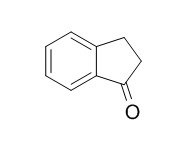1-Indanone
1-Indanone thiosemicarbazones coordinated to palladium(II) is more cytotoxic than those complexed with platinum(II); although platinum(II) is more selective for leukemic cells and has potential to treat hematological malignancies.
Inquire / Order:
manager@chemfaces.com
Technical Inquiries:
service@chemfaces.com
Tel:
+86-27-84237783
Fax:
+86-27-84254680
Address:
1 Building, No. 83, CheCheng Rd., Wuhan Economic and Technological Development Zone, Wuhan, Hubei 430056, PRC
Providing storage is as stated on the product vial and the vial is kept tightly sealed, the product can be stored for up to
24 months(2-8C).
Wherever possible, you should prepare and use solutions on the same day. However, if you need to make up stock solutions in advance, we recommend that you store the solution as aliquots in tightly sealed vials at -20C. Generally, these will be useable for up to two weeks. Before use, and prior to opening the vial we recommend that you allow your product to equilibrate to room temperature for at least 1 hour.
Need more advice on solubility, usage and handling? Please email to: service@chemfaces.com
The packaging of the product may have turned upside down during transportation, resulting in the natural compounds adhering to the neck or cap of the vial. take the vial out of its packaging and gently shake to let the compounds fall to the bottom of the vial. for liquid products, centrifuge at 200-500 RPM to gather the liquid at the bottom of the vial. try to avoid loss or contamination during handling.
J Ethnopharmacol.2019, 235:406-414
J Ethnopharmacol.2024, 335:118628.
Research on Crops.2017, 18(2)
Antiviral Res.2013, 98(3):386-93
J. Essential Oil Research2024, 6:36:554-565.
J Hepatocell Carcinoma.2022, 9:327-341.
Exp Parasitol.2017, 183:160-166
Bio-protocol2018, 9(14):e3301
Inflammation.2015, 38(4):1502-16
Anal Bioanal Chem.2020, 412(12):3005-3015.
Related and Featured Products
Eur J Pharm Sci. 2012 Oct 9;47(3):596-603.
Antiviral activity against the hepatitis C virus (HCV) of 1-indanone thiosemicarbazones and their inclusion complexes with hydroxypropyl-β-cyclodextrin.[Pubmed:
22885176 ]
The hepatitis C virus (HCV) is a major cause of acute and chronic hepatitis in humans. Approximately 5% of the infected people die from cirrhosis or hepatocellular carcinoma. The current standard therapy comprises a combination of pegylated-interferon alpha and ribavirin. Due to the relatively low effectiveness, the prohibitive costs and the extensive side effects of the treatment, an intense research for new direct-acting anti-HCV agents is taking place. Furthermore, NS3 protease inhibitors recently introduced into the market are not effective against all HCV subgenotypes. Thiosemicarbazones (TSCs) have shown antiviral activity against a wide range of DNA and RNA viruses. However, their extremely low aqueous solubility and high self-aggregation tendency often preclude their reliable biological evaluation in vitro.
METHODS AND RESULTS:
In this work, we investigated and compared for the first time the anti-HCV activity of two 1-Indanone TSCs, namely 5,6-dimethoxy-1-Indanone TSC and 5,6-dimethoxy-1-Indanone N4-allyl TSC, and their inclusion complexes with hydroxypropyl-β-cyclodextrin (HPβ-CD) in Huh-7.5 cells containing the full-length and the subgenomic subgenotype 1b HCV replicon system. Studies of physical stability in culture medium showed that free TSCs precipitated rapidly and formed submicron aggregates. Conversely, TSC complexation with HPβ-CD led to more stable systems with minimal size growth and drug concentration loss. More importantly, both TSCs and their inclusion complexes displayed a potent suppression of the HCV replication in both cell lines with no cytotoxic effects.
CONCLUSIONS:
The mechanism likely involves the inhibition of non-structural proteins of the virus. In addition, findings suggested that the cyclodextrin released the drug to the culture medium over time. This platform could be exploited for the study of the drug toxicity and pharmacokinetics animal models.
J Microbiol Biotechnol. 2012 Jun;22(6):832-7.
Oxidative potential of some endophytic fungi using 1-indanone as a substrate.[Pubmed:
22573162]
METHODS AND RESULTS:
The oxidative potential of the fungus Penicillium brasilianum, a strain isolated as an endophyte from a Meliaceae plant (Melia azedarach), was investigated using 1-Indanone as a substrate to track the production of monooxygenases. The fungus produced the dihydrocoumarin from 1-Indanone with the classical Baeyer-Villiger reaction regiochemistry, and (-)-(R)-3-hydroxy-1-Indanone with 78% ee. Minor compounds resulting from lipase and SAM activities were also detected. The biotransformation procedures were also applied to a collection of Penicillium and Aspergillus fungi obtained from M. azedarach and Murraya paniculata.
CONCLUSIONS:
The results showed that Baeyer-Villiger were mostly active in fungi isolated from M. azedarach. Almost all of the fungi tested produced 3-hydroxy-1-Indanone.
ChemMedChem. 2011 Aug 1;6(8):1485-94.
Synthesis, structural characterization, and pro-apoptotic activity of 1-indanone thiosemicarbazone platinum(II) and palladium(II) complexes: potential as antileukemic agents.[Pubmed:
21608131]
In the search for alternative chemotherapeutic strategies against leukemia, various 1-Indanone thiosemicarbazones, as well as eight novel platinum(II) and palladium(II) complexes, with the formula [MCl₂(HL)] and [M(HL)(L)]Cl, derived from two 1-Indanone thiosemicarbazones were synthesized and tested for antiproliferative activity against the human leukemia U937 cell line.
METHODS AND RESULTS:
The crystal structure of [Pt(HL1)(L1)]Cl·2MeOH, where L1=1-Indanone thiosemicarbazone, was solved by X-ray diffraction. Free thiosemicarbazone ligands showed no antiproliferative effect, but the corresponding platinum(II) and palladium(II) complexes inhibited cell proliferation and induced apoptosis. Platinum(II) complexes also displayed selective apoptotic activity in U937 cells but not in peripheral blood monocytes or the human hepatocellular carcinoma HepG2 cell line used to screen for potential hepatotoxicity.
CONCLUSIONS:
Present findings show that, in U937 cells, 1-Indanone thiosemicarbazones coordinated to palladium(II) were more cytotoxic than those complexed with platinum(II), although the latter were found to be more selective for leukemic cells suggesting that they are promising compounds with potential therapeutic application against hematological malignancies.



